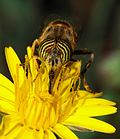Pollinator

A pollinator is an animal that does pollination. Pollination is almost entirely done by insects, though there are some exceptions. Some birds (such as hummingbirds) pollinate flowers as they take nectar. Overall, however, it is insects that pollinate. Bees, of course, pollinate flowers as they take nectar. But wasps, ants, flies, beetles, butterflies and moths all have many species which are pollinators. The plant which offers the pollen is called the pollenizer.
To be a pollinator, an insect has to move pollen from the male anther to the female stigma of a flower. The pollinator gets away with much of the pollen for its own use.[1]
Although it is obvious that flowering plants are the plants which usually offer pollen, there is a pre-history of pollination in cycads.[2]
Bees may not be the most numerous insects which take up the pollen. Hoverflies (Syrphidae) are very numerous visitors to flowers,[3] and they may be more numerous than bees in many environments.
The list of pollinators is long. Bees, wasps, ants, flies, mosquitoes, lepidoptera and beetles all have some pollinators who take nectar, and also some vertebrates: bats, birds, monkeys, lemurs, possums, rodents.
Wild pollinators often visit many plant species, and plants are visited by many pollinator species. All these relations together form a network of interactions between plants and pollinators. Surprising similarities exist in the networks of interactions between plants and pollinators. This structure is similar in very different ecosystems on different continents, consisting of entirely different species.[4]
Pollinator Media
A syrphid fly (Eristalinus taeniops) pollinating a common hawkweed
A mining bee (Andrena lonicerae) pollinating a honeysuckle (Lonicera gracilipes).
Honey bee pollinating a plum tree. Bees are the most effective insect pollinators.
An Australian painted lady feeding on nectar
A Scoliid wasp (Scolia chrysotricha) foraging
Green violetear with pollen on bill, Curi Cancha Wildlife Refuge, Costa Rica
References
- ↑ Fægri K. and L. van der Pijl. 1979. The principles of pollination ecology. Oxford: Pergamon.
- ↑ Dennis Wm. Stevenson; Knut J. Norstog & Priscilla K.S. Fawcett 1998. Pollination biology of cycads. In S.J. Owens & P.J. Rudall (eds) Reproductive biology. Royal Botanic Gardens, Kew.
- ↑ Gilbert, Francis S. 1986. Hoverflies. Cambridge University Press. ISBN 0-521-27701-9
- ↑ Bascompte J; Jordano P; Melián C.J. & Olesen J.M. 2003. The nested assembly of plant–animal mutualistic networks. Proceedings of the National Academy of Sciences, 100 (16), 9383-9387. [1]






